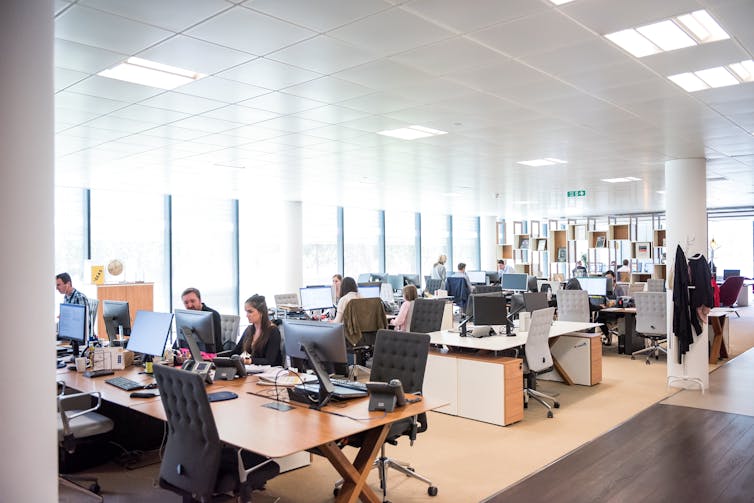We know regular exercise is really good for health, but even with the best of intentions, many workers do not exercise as much as they should. To get more workers in all types of workplaces to be active, public health messaging must move away from making it only an individual’s responsibility to be more active. It should instead recognize the important role employers can play in creating the conditions for workers to focus on exercise.
There’s much to be said for this approach. From a public health perspective, focusing on workplaces can seem like low-hanging fruit, since they are settings where people already go every day. Consider the resources that would otherwise be required to build activity-friendly environments, let alone address the root social causes of physical inactivity. However, the reality is more complicated.

(Shutterstock)
The World Health Organization’s physical activity guidelines recommend adults strive for at least 150-300 minutes of moderate-intensity aerobic physical activity, or 75-150 minutes of vigorous-intensity aerobic physical activity, or an equivalent combination every week. To meet these recommendations, for 80 per cent of working-age Canadians in full-time jobs, it means finding time to exercise before, after or at work.
That’s easier for some than others. I am part of a team at the Institute for Work and Health that published a paper showing that people in certain work conditions are less likely to exercise. These are workers who: report long work hours, have little say in how to use their skills, or are in physically or psychologically demanding jobs.
Other studies have reported the same. These findings support the theory that stressful and strenuous working conditions can increase a worker’s fatigue and decrease motivation and perceived time available to exercise.
Workplace spillover

(Shutterstock)
The spillover of strenuous working lives on exercise participation is a reality for many people — especially when there are competing demands such as taking care of children. But the ability to overcome these barriers can depend on job type.
Supportive workplace facilities that offer standing desks, stairs, on-site showers and gyms and easy access to walking paths can make it easier for people to fit in exercise and reduce sedentary time. However, these are mostly available to white-collar, higher-income workers who already face fewer barriers to exercise outside of work.
Read more:
Lack of exercise linked to increased risk of severe COVID-19
Emphasizing worker responsibility for exercising more can exacerbate health inequalities between high- and low-income workers. Low-income workers in non-standard or precarious jobs often have little say about how they spend their work time. These workers also have few opportunities to exercise and engage in other healthy behaviours outside work.
Some manual labour jobs involve high levels of physical activity with little time to rest, while workers in service sector jobs can spend long periods of time standing. A body of research is showing the potential harm of these occupational activities — including the risks of physical activity for people doing such jobs. Job-related physical activity often does not provide the same health benefits of leisure-time exercise, and can even have negative effects because of factors like the nature of the movements and duration of work.
Healthy workers are safer workers

(Shutterstock)
Physical activity guidelines aimed at all adults will not be achievable for many workers. A more inclusive solution is for employers to create the conditions for their workers to thrive so that they can also prioritize their health.
This approach pushes for employers to think of workplace policies as levers to address the safety, health and well-being of their workers. Research shows that healthy workers are safe workers, and this concept is endorsed by international labour agencies and the Total Worker Health program in the United States.
What could such an approach look like? One example is the case of an insurance company offering flexible scheduling and telecommuting options to help its workers reduce their stress. This led to workers walking more, taking breaks away from their desks and engaging in stress-reducing social activities such as ping-pong competitions and indoor nerf basketball tournaments.
At one construction company, a 14-week intervention focused on health education, reinforcing safety and health behaviours and improving work-life balance. The result was more workers reporting exercising at least 30 minutes a day.
In another example, a police department reduced the number of night shifts for its officers. It also offered mental health support and allowed staff to take one hour off each shift to exercise. The result was a reduction in workplace injuries.
Enhancing working conditions

(Unsplash/Arlington Research)
So how do we get more employers to get behind this? Our team’s research in Canada and other studies have highlighted the importance of convincing employers with data that this approach can be successful. For example, an employer-led approach has increased participation in safety and wellness efforts, and reduced workplace injuries and health-care costs.
Employers that want to create an environment conducive to the safety, health and well-being of their employees should discuss with their workers how policies and practices could support those goals.
While there is no simple solution to getting workers more physically active, an important step forward is to get employers involved in enhancing working conditions so that more Canadian workers are supported in getting the health benefits of regular exercise.





